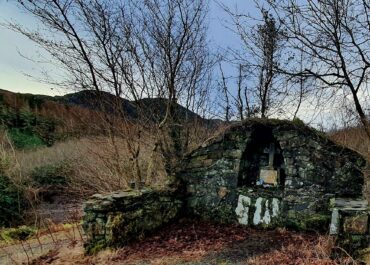Church, Ramelton, Co. Donegal
Hidden beneath a thick coat of ivy in County Donegal stands Tullyaughnish Old Church, a fascinating relic of 17th century Protestant church building in Ulster.
Church, Ramelton, Co. Donegal
Commissioned by Sir William Stewart and nearly finished by 1622, this rubble-built structure served the local community for two centuries until a new parish church replaced it in the 1820s. Measuring 22.4 by 7.2 metres internally, the church features distinctive set-back corner buttresses and a rather peculiar architectural mix that tells the story of multiple building phases and alterations.
The most striking feature is the four-light east window, which creates an oddly anachronistic impression with its unusually thick mullions and debased Perpendicular Gothic style. The tracery appears to have been cobbled together from various sources; the dagger-shaped centrepiece looks out of place, whilst two moulded sections from another window have been awkwardly incorporated into the design. This haphazard arrangement likely resulted from a later “Gothick” reconstruction, possibly during major refurbishments that saw significant changes to the building. The south wall’s four large segment-headed windows and evidence of rebuilding in the upper sections confirm that the church underwent substantial alterations, whilst blocked-up windows along the north wall reveal where original 17th century openings were demolished and filled in.
Perhaps the most intriguing element is a carved lintel above the east window, decorated with a stylised tree flanked by two lion-like creatures. This 12th century piece was salvaged from an older church on nearby Aughnish Island, providing a tangible link to the medieval ecclesiastical history of the area. The western gable once featured a large central oculus, now blocked up, and the lower courses of a bellcote that was partially preserved when the gable was raised on either side. The moulded sandstone doorway appears to be another secondary reconstruction, its embrasure reduced in width and one jamb stone missing, adding to the building’s complex architectural biography.


